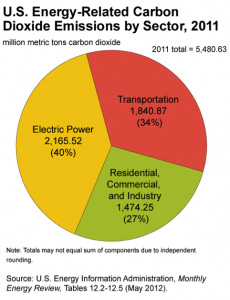Recycling electricity decreases a building’s carbon footprint and works toward net zero energy by reducing the amount of electricity needed. This energy reduction also lessens the environmental impact of all sources of electricity by making every kilowatt-hour produced more efficient.

Make renewable sources like solar or wind power more effective:
- By decreasing the amount of electricity needed, electricity generated by renewable sources can meet more of the energy needs of the building.
Approach net-zero energy:
- Net-zero energy buildings have zero carbon emissions and a net zero consumption of energy. Recycling electricity is a step used to bring a building to net zero by reducing its energy consumption.
Reduce pollution:
- Lower pollution from fuels like coal by reducing the amount of electricity purchased
40% of all carbon dioxide produced in the US comes from electricity generation, according to the Energy Information Administration (EIA). Any effort that reduces the amount of electricity needed has a large impact on the greatest source of CO2 emissions in the US.
The amount of electricity generated by different sources varies from state to state. For a detailed breakdown of energy in your state see chart below or visit http://www.eia.gov/state/
For a breakdown of the environmental savings by state, please consult the table below. The table lists the pounds of carbon dioxide (CO2) emitted into the atmosphere for each 1000 kWh generated for each state. It also lists the number of trees that would have to be planted to absorb and therefore offset that CO2 for the same 1000kWh. This data is calculated from the state wide averages from the Department of Energy and the EPA.
| Region/State | CO2 / 1000 kWh | Trees / 1000 kWh |
|---|---|---|
| New England | 980 | 11.5 |
| Connecticut | 940 | 11.1 |
| Maine | 850 | 10 |
| Massachusetts | 1280 | 15 |
| New Hampshire | 680 | 8 |
| Rhode Island | 1050 | 12.3 |
| Vermont | 30 | .4 |
| Mid Atlantic | 1040 | 12.2 |
| New Jersey | 710 | 8.3 |
| New York | 860 | 10.1 |
| Pennsylvania | 1260 | 14.8 |
| East-North Central | 1630 | 19.2 |
| Illinois | 1160 | 13.6 |
| Indiana | 2080 | 24.5 |
| Michigan | 1580 | 18.6 |
| Ohio | 1800 | 21.2 |
| Wisconsin | 1640 | 19.3 |
| West-North Central | 1730 | 20.3 |
| Iowa | 1880 | 22.1 |
| Kansas | 1680 | 19.7 |
| Minnesota | 1520 | 17.9 |
| Missouri | 1840 | 21.6 |
| Nebraska | 1400 | 16.5 |
| North Dakota | 2240 | 26.3 |
| South Dakota | 800 | 9.4 |
| South Atlantic | 1350 | 15.9 |
| Delaware | 1830 | 21.5 |
| Florida | 1390 | 16.3 |
| Georgia | 1370 | 16.1 |
| Maryland* | 1370 | 16.1 |
| North Carolina | 1240 | 14.6 |
| South Carolina | 830 | 9.8 |
| Virginia | 1160 | 13.6 |
| West Virginia | 1980 | 23.3 |
| East-South Central | 1490 | 17.5 |
| Alabama | 1310 | 15.4 |
| Kentucky | 2010 | 23.6 |
| Mississippi | 1290 | 15.2 |
| Tennessee | 1300 | 15.3 |
| West-South Central | 1430 | 16.8 |
| Arkansas | 1290 | 15.2 |
| Louisiana | 1180 | 13.9 |
| Oklahoma | 1720 | 20.2 |
| Texas | 1460 | 17.2 |
| Mountain | 1560 | 18.3 |
| Arizona | 1050 | 12.3 |
| Colorado | 1930 | 22.7 |
| Idaho | 30 | .4 |
| Montana | 1430 | 16.8 |
| Nevada | 1520 | 17.9 |
| New Mexico | 2020 | 23.7 |
| Utah | 1930 | 22.7 |
| Wyoming | 2150 | 25.3 |
| Pacific Contiguous | 450 | 5.3 |
| California | 610 | 7.2 |
| Oregon | 280 | 3.3 |
| Washington | 250 | 2.9 |
| Pacific Non-contiguous | 1560 | 18.3 |
| Alaska | 1380 | 16.2 |
| Hawaii | 1660 | 19.5 |
| U.S. Average | 1340 | 15.8 |
*Includes the District of Columbia
